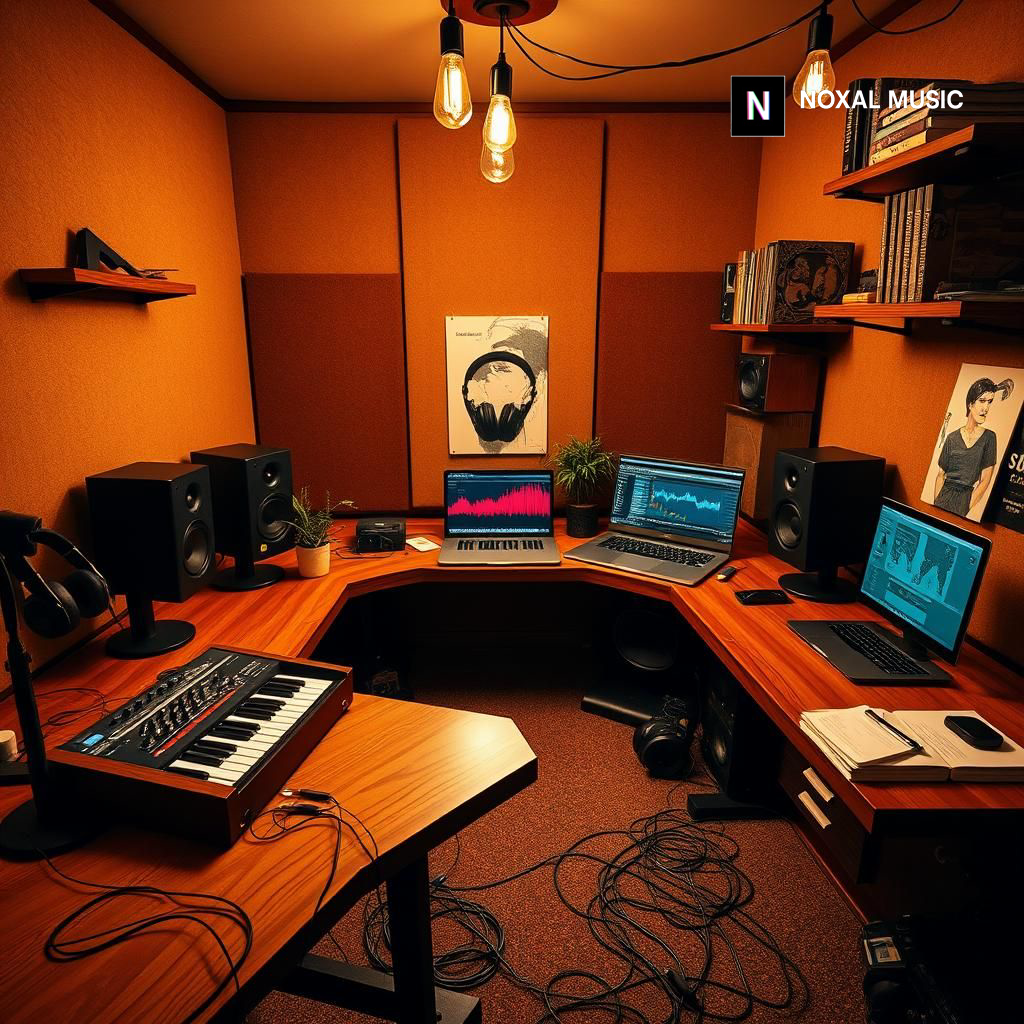Beyond the Preset: Mastering Synth Layering for Unforgettable Productions
At Noxal, we explore the powerful technique of synth layering to enhance your music productions. Layering goes beyond mere sound stacking; it creates depth, richness, and unique identity in your tracks. Join us as we delve into the art of layering and provide practical steps to elevate your sound design.
- Layering enhances sound depth and complexity.
- Utilizing different synth characteristics creates unique timbres.
- Understanding both functional and textural layering methods.
- Practical steps for effective synth layering in music production.
- Encouragement for sonic exploration and experimentation.
Estimated reading time: 12 minutes
Table of Contents
- The Art of Layering: A Core Synth Topic in Music Production
- Deconstructing a Classic: The Bassline of Daft Punk’s “Around the World”
- Your Workshop: Practical Steps for Synth Layering
- Beyond the Blueprint: Encouraging Your Own Sonic Explorations
- The Layers of Your Sonic Future
- FAQ
The Art of Layering: A Core Synth Topic in Music Production
So, what exactly is synth layering, and why is it so vital in modern production? Simply put, layering involves combining two or more synthesizer sounds (or even different patches from the same synth) to create a single, more complex, and often more powerful composite sound. It’s not just about making things louder; it’s about enriching the frequency spectrum, adding dynamic movement, and crafting unique timbres that stand out.
Think of it like cooking. You don’t just use one spice for a dish; you combine herbs, salts, and other ingredients to build a nuanced flavor profile. A single synth patch, while potentially inspiring, often occupies a limited sonic space. It might be great in the mid-range but lack the foundational weight of a sub-bass or the sparkling detail of a high-end texture. Layering allows you to:
- Add Depth and Dimension: By combining sounds with different characteristics, you create a sound that feels more three-dimensional and alive.
- Increase Power and Presence: Multiple sounds working in harmony can fill out the frequency spectrum more effectively.
- Create Unique Timbres: Carefully selecting and blending different waveforms and filter settings to create entirely new sounds.
- Overcome Limitations: A single synth might not have the sonic flexibility you need.
- Achieve Specific Functions: Layer different waveforms to serve the purpose of a cohesive sound.
We at Noxal often discuss the distinction between functional layering and textural layering. Functional layering aims to create a sound that fulfills a specific role in the mix, while textural layering enhances the atmosphere of a track. Both are equally valid and powerful applications of this essential synth topic in music production.
Deconstructing a Classic: The Bassline of Daft Punk’s “Around the World”
To appreciate layering’s power, let’s examine Daft Punk’s “Around the World.” This track exemplifies effective synth layering for a bass sound that grooves and commands attention. Upon first hearing it, the bassline captivated me with its presence and movement—proof that it couldn’t be a single synth patch.
Here’s a breakdown of what makes that legendary bassline:
- The Sub-Bass Foundation:
- Purpose: To provide deep low-end that you feel.
- Likely Sound Source: A clean sine wave or a low-pass filtered saw wave from an analog synth.
- Characteristics: Monophonic and low in volume but crucial for power.
- The Mid-Bass Body:
- Purpose: To give the bassline its core identity.
- Likely Sound Source: A distorted or saturated saw or square wave.
- Characteristics: Detuned from the sub-bass for width.
- The Mid-High Pluck/Character:
- Purpose: To add a percussive transient that helps the bassline cut through.
- Likely Sound Source: A pulse wave with a fast decay envelope.
- Characteristics: Occupies the higher end of the bass frequency spectrum.
The genius of Daft Punk lies not just in these sounds, but in how they were mixed and processed, creating a powerful, articulate, and immensely groovy bassline. It’s a perfect illustration of how effective synth layering can turn a simple melodic idea into a legendary sound.
Your Workshop: Practical Steps for Synth Layering
Integrating synth layering into your production workflow might seem daunting, but with a structured approach, it becomes rewarding. Here are practical steps we at Noxal recommend:
- Define Your Goal: What sound are you building?
- Choose Your Foundation: Start with an important element.
- Add Complementary Layers: Build out the spectrum.
- EQ for Clarity: The unsung hero of layering.
- Stereo Widening & Panning: Create space and excitement.
- Effects & Dynamics: Glue it all together.
- Experimentation is Key: Break the rules!
Beyond the Blueprint: Encouraging Your Own Sonic Explorations
The beauty of synth layering is that it allows for creating robust and unique sounds. While deconstructing classic synth sounds offers invaluable insights, the ultimate goal is inspiration for your own sonic adventures. We encourage experimentation at Noxal. Think about how different elements combine to create new timbres.
Consider ideas for your explorations such as:
- Hybrid Layering: Combine samples with synthesizers.
- Unconventional Modulation: Apply complex LFOs to your layered synths.
- Dynamic Layering: Use velocity to alter different layers.
- Processing Chains on Individual Layers: Create different effect chains for each layer.
- Exploring Different Synths: Experiment with various digital synthesizers and analog synths.
The Layers of Your Sonic Future
Mastering synth layering is a fundamental approach to synth topics in music production that will enhance your ability to craft original sounds. The power of combining synths is immense; from creating basslines to ethereal pads, layering is transformative.
We encourage you to take the principles we’ve discussed and apply them in your own studio. Listen critically to your favorite tracks and explore your sonic masterpieces. The world of electronic music is vast, and learning to layer effectively will greatly benefit your creative synthesis.
FAQ
What are the benefits of synth layering?
Layering enriches the sound, adds depth, and creates unique sonic textures, enhancing the overall production quality.
Can I layer different types of synthesizers?
Yes! Layering different synthesizer types—analog, digital, virtual—can create unique combinations of sound.
How do I ensure my layers work together well?
Use EQ to carve out distinct frequency spaces for each layer, and ensure each layer contributes positively to the overall sound.
What role does experimentation play in synth layering?
Experimentation is key! It allows you to discover unique combinations and timbres that can lead to creative breakthroughs in your music.

